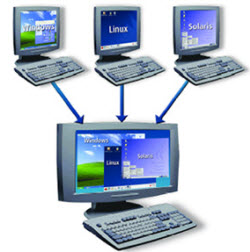Some technology is innovative and impressive, but doesn't serve a business need. For example, you keep hearing about Cloud Computing. Yet, how likely is it that you're going to
allow your business to put a bunch of your proprietary data out on the net
anytime soon?
I'm not saying bad things about clouds, I'm just saying that there are a number of other recent advances that are interesting and perhaps more relevant. Some of these advances promise to save time and money while
making the computer environment safer and more robust. An example is the class of solutions that take advantage of shared resources (like database clustering and virtualizing
servers and desktops).
 For us, one of the biggest changes in information technology, recently, has been the increasing use of virtualization.
For us, one of the biggest changes in information technology, recently, has been the increasing use of virtualization.
What is Virtualization?
Several years ago, I needed to purchase a big and powerful computer to run certain in-depth tests. Yet, only a small percent of the tests we run require a machine that big. Some of our other testing took a long time, but didn't require many of the computer's resources. In both cases, we were dramatically under-using the machine a majority of the time.
With virtualization, you can take a big powerful machine and divide it into smaller less powerful machines when you need to.
That means you can use all of the machine's capacity for one purpose some of the time. While other times, you can load a configuration optimized for a different type of test, which lets you create more virtual machines.
So, if you are running a test that might take one computer 24 hours to run (but didn't use much of the computer's processing power), you could use virtualization to split the computer into four virtual computers. The result is that it might only take you six or seven hours to complete the same task.
That is a simple example, but hopefully it gives you an idea of what is possible.
There are two main players in this space, Microsoft and VMware.
Virtual PCs Move to the Desktop.
That same technology has moved to the desktop.
For example, Windows 7 comes with Microsoft's Virtual PC. This makes it easy for you to create a clone of the computer (running inside your computer) but that doesn't affect the primary operating system.
You can use a different operating system in the Virtual PC. So, even
though you might use Windows 7, you could setup the Virtual PC to run
with Windows XP or even Linux (for compatibility or testing reasons).
Another use of a Virtual PC is as a "sandbox" that lets you install and try software that you wouldn't otherwise try on your main computer.
For example, Microsoft just came-out with a beta version of its Office 2010 product. I asked some of our IT staff if I should install it on my PC to try. When they stopped laughing at me, the answer was "absolutely not", because it might hang, damage something or create the need to re-install the computer. A Virtual PC, however, is a great place to try something like that without risking your primary work environment.
Give it a try.
Resources:
- Here is a link to Microsoft's page for Virtual PC
- Here is a link to a tool to make a Virtual PC from a live Windows install.
- Here is a link to VMware's page for the Desktop Player.
- Here is a link to a tool to make VMware images from an operating system.
- Here is a link to an open source solution from Sun called Virtual Box.
- Here is a link to Virtual Box Images

Hi Howard,
Great article and nice introduction to the world of virtualization. The term can definitely get confusing.
I agree that every CIO and IT department should give virtualization a try.
Microsoft offers great new products that should give VMware users some awesome alternatives!
We actually tweet about Windows 7 Enterprise and virtualization. Would love to hear your opinion on some of the virtualization issues we bring up if you’re also on Twitter.
We are @CIOsConnect, the official Twitter feed for Windows 7 Enterprise users, Technical Decision Makers, CIOs, etc.
Hope to hear from you,
Regards
Alex
Microsoft Windows Client Team